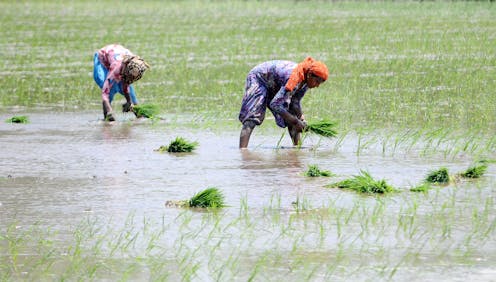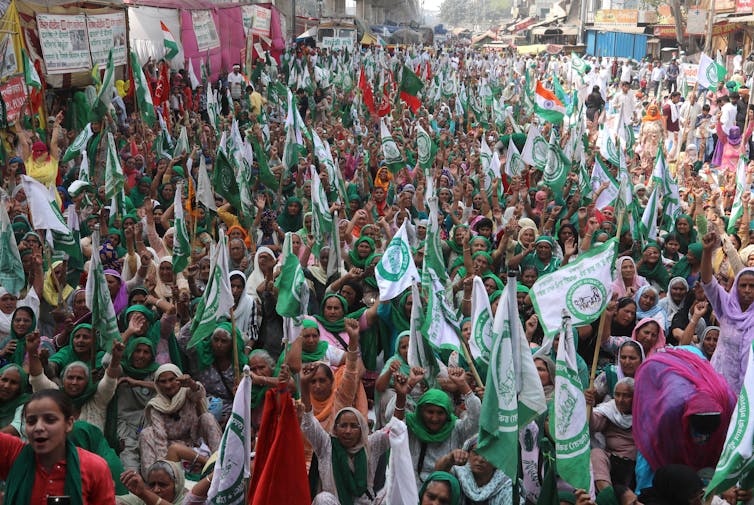Women grow as much as 80% of India's food – but its new farm laws overlook their struggles
Most Indian farmers are women. But few own their land, and gender inequality limits their access to markets. These issues won't be fixed by recent agricultural reforms; in fact, they may get worse.

Indian women are left behind on farms to make ends meet as more men in India migrate from rural areas to cities, seeking higher incomes and better jobs.
Nearly 75% of the full-time workers on Indian farms are women, according to the international humanitarian group OXFAM. Female farmers produce 60% to 80% of the South Asian country’s food.
So it’s little surprise women are playing a visible role in the monthslong nationwide protests against agricultural reforms passed last September by the Indian government.
Small farmers are particularly vulnerable to three new laws, which deregulated the agricultural market and weakened the government-established minimum sale price for crops in ways that, demonstrators say, could pit small farmers against big agribusiness firms.
And women, as the most marginal of India’s small farmers, may suffer the most if the laws go into effect.
“We barely have any land. If that too is gifted to [billionaires], then what will we eat?” 69-year-old Surinder Kaur, a member of the Kisan Sabha farmers union, told the Indian digital news site The Wire when asked why she was protesting.

Invisible, unpaid labor force
In a given crop season, when fields are sown and harvested, women farmers in India work about 3,300 hours, double the 1,860 hours their male counterparts put into farming.
Yet their work feeding their families and the country remains undervalued and largely overlooked by the government.
“Women become de facto farm managers when men shift to non-farm jobs, but are not recognized as such because they seldom own the farm,” according to the Indian development economist Bina Agarwal.
One-third of female farmers in India are unpaid laborers on family farms owned by their parents, husbands or in-laws, according to OXFAM. Indian women own just 12.8% of the country’s land.
The imbalance in access to property has partly to do with India’s inheritance laws. Hindu, Jain, Sikh and Buddhist women in India were given equal inheritance rights to ancestral property in 2005 – legally, if not always in practice. Women of other faiths have separate personal laws governing property rights in India.
Since over 90% of agricultural land in India is transferred through inheritance, women remain stuck as laborers for generation after generation, never owning the land they work, or even their own homes.
No title, no money
Women with strong property and inheritance rights earn nearly four times more money, the land rights nonprofit organization Landesa stated in a 2018 report.
Land is an asset that can be used not only for agricultural production but also as collateral to access credit, government programs that support farmers, even pensions. But to get these opportunities, a land title is required. An OXFAM study in Uttar Pradesh state found that just 4% of female farmers have access to institutional credit.
When three-quarters of all a country’s farmers are women, their problems become a problem for the entire nation. Researchers in India call this the “feminization of its agrarian distress.”
And India’s agriculture problems are severe indeed. Farmers face declining plot sizes, degraded soils, scarce water and rising debt. In the past 25 years, over 300,000 desperate, debt-ridden farmers in the country have committed suicide.
Suicide rates for female farmers are often underrepresented in the data because of their lack of land titles, but the numbers are also increasing. According to the news site Al Jazeera, which accessed a government database collected by local authorities in the Amravati district of the western Indian state of Maharashtra, an average of one female farmer there takes her own life each month.
“We plow the fields, and we feed the country. This struggle is for our rights,” Norinder Kaur, 70, told the women’s news site The Lily at a protest on March 2.

Unequal market access
One particular aspect of India’s new farm laws, the elimination of a government-regulated middleman agency from crop sales, is likely to have different outcomes for woman than for men.
For women, the government-regulated market negotiators were an avenue for bargaining and price discovery that did not require women to physically enter the male-dominated agricultural markets and haggle with traders over crop prices.
The Indian government says a freer market will enable farmers to sell or purchase agricultural produce anywhere in the country, helping them get a better price. But entrenched gender inequality makes Indian female farmers much less able to travel than men, so their access to markets may now be limited.
However imperfect, India’s past agricultural regulations at least ensured that crop sale prices nationwide in India remained close to the price floor set by the government, said the Mahila Kisan Adhikar Manch – an informal grouping of some 120 women farmers organizations and their allies – in a statement.
The group fears the new “era of fragmented and unregulated markets” will be even less “women farmer-friendly” than the old system.
Limited access to justice
India’s agricultural reforms may also hurt women’s ability to resolve agricultural disputes.
Under the new laws, problems among the farmers and traders or agribusiness firms would be settled by a new agricultural board, not the local courts as is done now.
Women’s access to the legal system in India is already limited. But going forward, if agribusiness firms file a claim in a far-off jurisdiction, female farmers who lack access to transport and money to travel would be at an even greater disadvantage.
“We work on the fields too, and we put our sweat and blood into our day,” said Nimrat Deep Kaur, a 45-year-old agricultural laborer, interviewed at a Marchfarmers protest on March 2. “I am here so I can raise my voice as an equal with the men who are protesting.”
The authors do not work for, consult, own shares in or receive funding from any company or organization that would benefit from this article, and have disclosed no relevant affiliations beyond their academic appointment.
Read These Next
Billions of cicadas are about to emerge from underground in a rare double-brood convergence
The last time that these two groups of cicadas emerged from underground together, Thomas Jefferson was…
AI chatbots refuse to produce ‘controversial’ output − why that’s a free speech problem
AI chatbot makers’ restrictive use policies hinder people’s access to information.
Cities with Black women police chiefs had less street violence during 2020’s Black Lives Matter prot
The type of life and professional experience a police chief has can influence how their departments…



